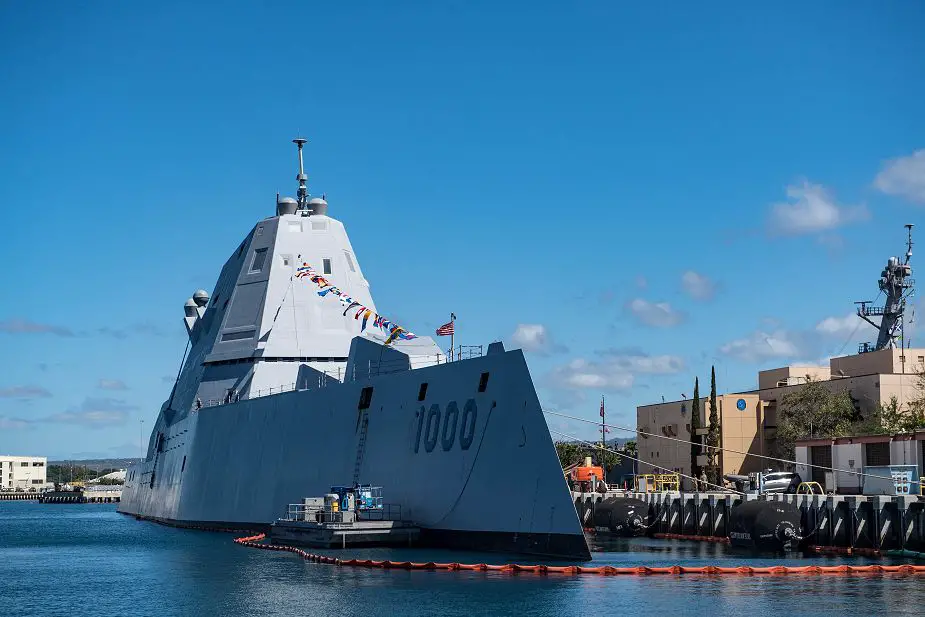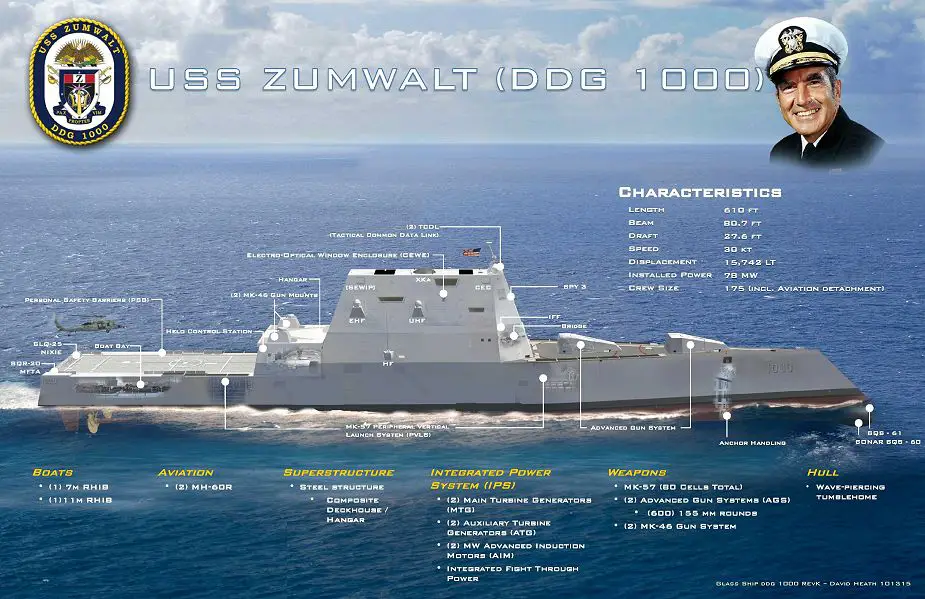Navy recognition editorial team publish analysis about the ship self defense program for DDG 1000 Zumwalt-class destroyer of U.S. Navy. The U.S. Navy's USS Zumwalt (DDG 1000) is the largest and most technologically advanced surface combatant in the world. Zumwalt is the lead ship of a class of modern generation multi-mission destroyers designed to strengthen naval power from the sea.
 The guided-missile destroyer USS Zumwalt (DDG 1000) is pierside in Pearl Harbor during a port visit. Zumwalt is conducting the port visit as part of its routine operations in the eastern Pacific. (Picture source U.S. Navy)
The guided-missile destroyer USS Zumwalt (DDG 1000) is pierside in Pearl Harbor during a port visit. Zumwalt is conducting the port visit as part of its routine operations in the eastern Pacific. (Picture source U.S. Navy)
The onboard DDG 1000 self-defense systems (TSCE, SPY-3, CEC, SEWIP Block 2, ESSM and SM-2 with JUWL, and VLS) are used to protect the ship and its sailors from enemy air threats in both clear and jammed environments.
The Zumwalt-class (DDG 1000) is the largest and most technologically advanced surface combatant in the world. USS Zumwalt is the lead ship of a class of next-generation multi-mission destroyers designed to strengthen naval power from the sea.
The DDG 1000 ship self-defense combat system, Zumwalt Combat System (ZCS), consists of several programs including total Ship Computing Environment (TSCE) and Cooperative Engagement Capability (CEC) with tracker and sensor data fusion and distribution system.
DDG 1000 will employ active and passive sensors and a Multi-Function Radar (MFR) capable of conducting area air surveillance, including over-land search and track, throughout the extremely difficult and cluttered sea-land interface.
The DDG 1000 is also equipped with the Multi-Function Radar (MFR/SPY-3), an active electronically scanned array radar manufactured by Raytheon and designed for both blue-water and littoral operations. AN/SPY-3, operating at X-band with high-accuracy, narrow beam width and wide frequency bandwidth, provides superior coverage and effective discrimination of low-altitude targets. It also provides target illumination and uplink/downlink capabilities for SM-2 and Evolved SeaSparrow missiles. Using S-band, VSR delivers effective, all-weather search capabilities via its high-power aperture, and narrow beam width, enabling it to accurately resolve and track targets.

Onboard armament of the guided-missile destroyer USS Zumwalt (DDG 1000).
Missile system of Zumwalt-class (DDG 1000) includes Evolved Sea Sparrow Missile (ESSM) Block 1 surface-to-air missile with Joint Universal Weapon Link (JUWL). This short-range missile interceptor is used to defeat air threats at close-in ranges as well as for radar-missile communication and support.
Missile systems of DDG 1000 also include Standard SM-2 Block IIIAZ with JUWL, the unique ZCS (Zumwalt-class) variant of SM-2 used to defeat air threats at longer ranges. In 2016, the U.S. Navy began procuring kits to modify SM-2 Block IIIA missiles into Block IIIAZ weapons that are compatible with the Zumwalt-class. The medium range SM-2 Block IIIB surface-to-air missile incorporates an infrared guidance mode capability developed with the radio frequency semi-active guidance system of the Block IIIA. Called the Missile Homing Improvement Program (MHIP), the dual radio frequency and infrared guidance mode is being incorporated to counter specific proliferating electronic warfare systems in existing aircraft and anti-ship cruise missile threats.
The DDG 1000 is equipped with 20×4, 80 cells of MK 57 VLS (Vertical Launch System) modules. The MK 57 launchers are contained and protected by the Peripheral Vertical Launch System*. The PVLS’ design and positioning make the launchers – and missiles – resistant to battle damage and safely isolates them from the crew and shipboard equipment. The MK 57 VLS is designed to accommodate both current and future missile technologies without major launcher modifications. It is flexible enough to handle lighter missiles, such as the Evolved Seasparrow, as well as the larger, heavier missiles required for ballistic missile defense.
The Advanced Gun System of the DDG 1000 consists of 155 mm naval gun, two of which are installed in each ship. This system consists of an advanced 155 mm gun and its Long Range Land Attack Projectile (LRLAP). This projectile is a rocket with a warhead fired from the AGS gun; the warhead has an 11 kg / 24 lb bursting charge and has a circular error probable of 50 meters. This weapon system has a range of 83 nautical miles (154 km). The fully automated storage system has room for up to 750 rounds. The barrel is water-cooled to prevent overheating and allows a rate of fire of 10 rounds per minute per gun. Using a Multiple Rounds Simultaneous Impact (MRSI) firing tactic the combined firepower from a pair of turrets gives each Zumwalt-class destroyer initial strike firepower equivalent to 12 conventional M198 field guns.
The onboard gun system also includes 2 x Mk-46 Mod. 2 30mm Gun Weapon System (GWS). The Mark 46 GWS is a remotely operated naval gun system that uses 30mm high-velocity cannon, a forward-looking infrared sensor, a low light television camera, and a laser rangefinder for shipboard self-defense against small, high speed surface targets.



